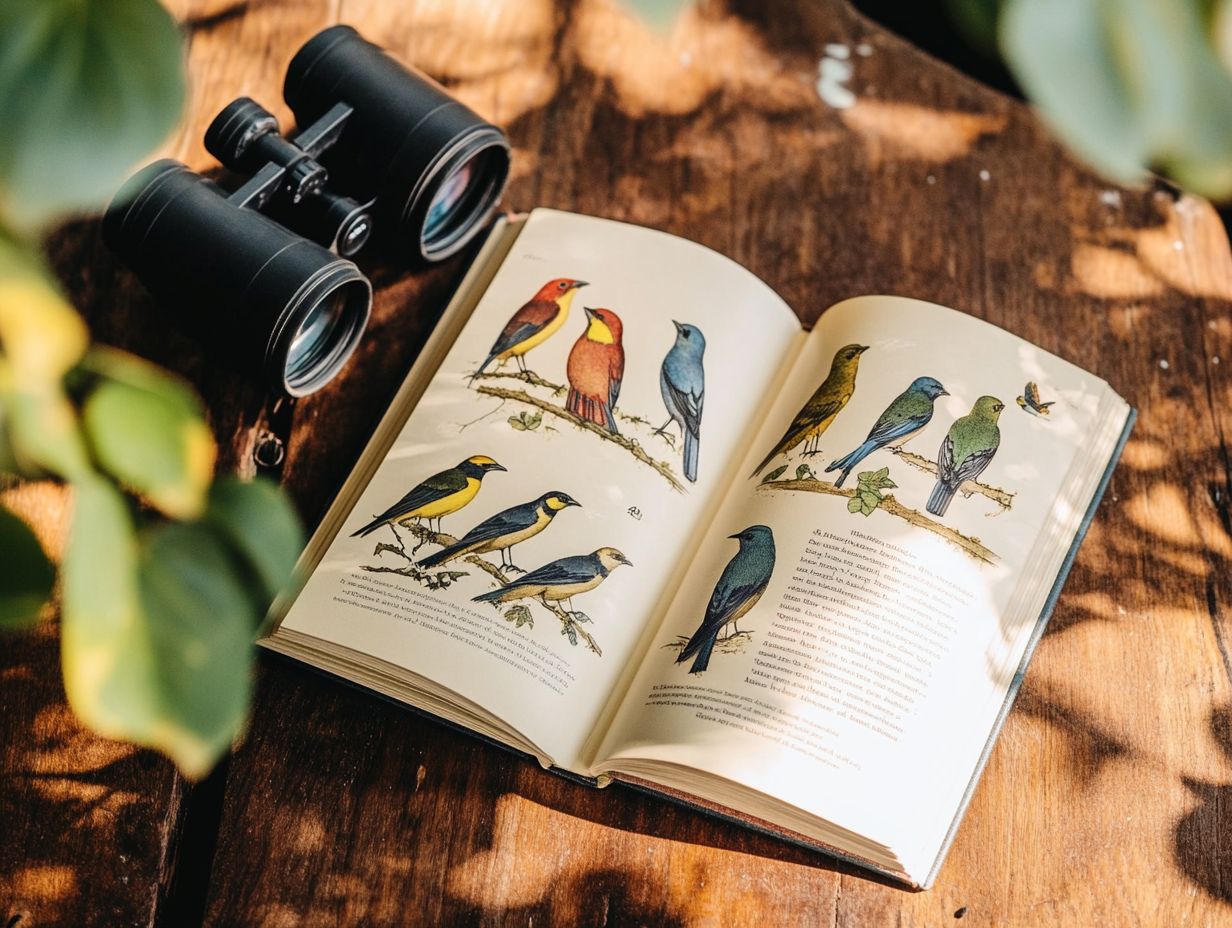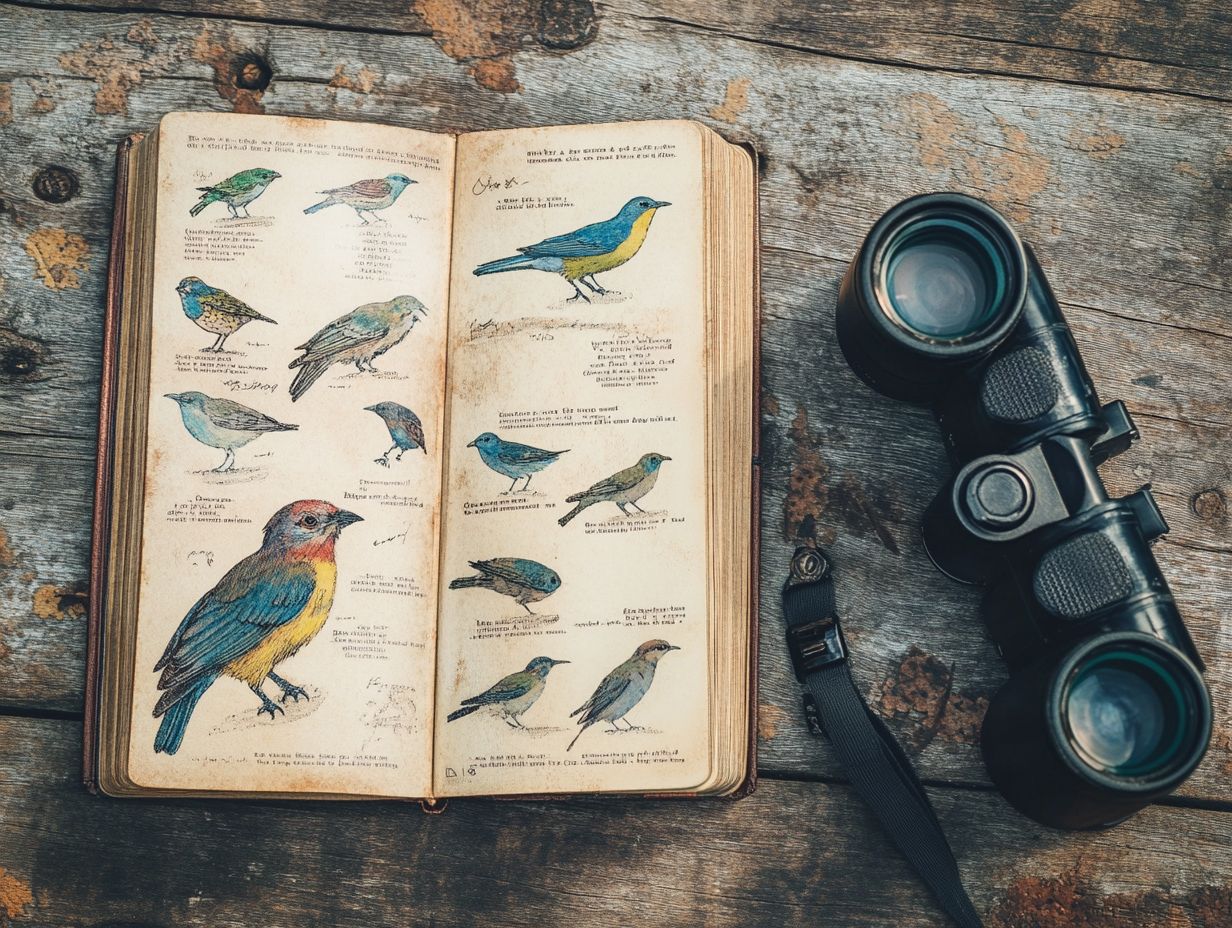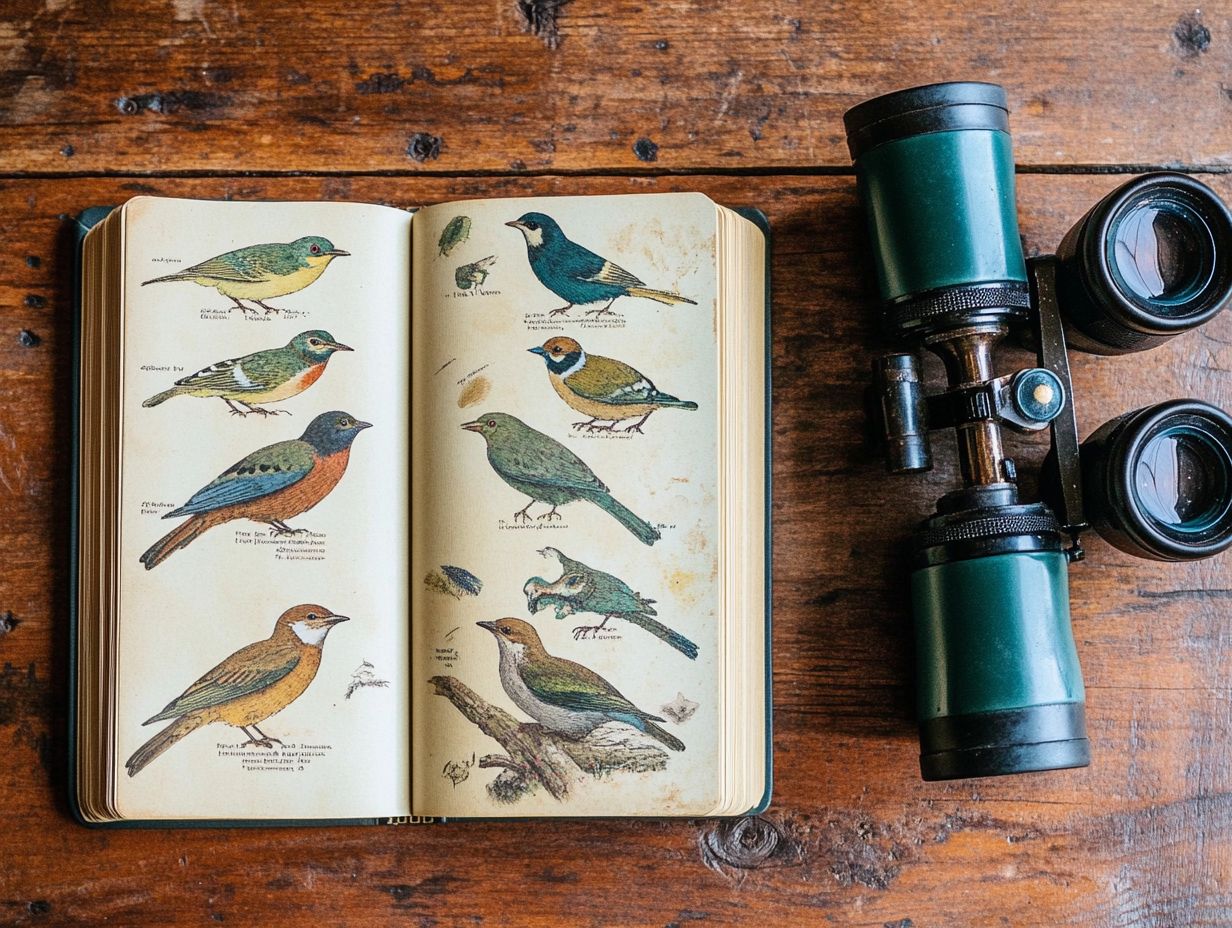Understanding the Layout of Bird Field Guides
Bird field guides serve as indispensable tools for both novice birdwatchers and experienced birdwatchers alike, providing you with an entry point into the captivating realm of avian life and birding.
This article delves into what a bird field guide is, highlighting its various types from regional to digital guides and mobile apps and the key features that contribute to their effectiveness.
You ll discover a practical step-by-step guide on how to utilize these guides, complemented by insightful tips to help you select the perfect one for your specific needs.
Whether you’re observing birds in your backyard or exploring a national park, mastering the art of navigating bird field guides will undoubtedly elevate your birdwatching experience and assist you with bird identification.
Contents
- Key Takeaways:
- What is a Bird Field Guide?
- Types of Bird Field Guides
- Features of a Bird Field Guide
- How to Use a Bird Field Guide
- Choosing the Right Bird Field Guide
- Frequently Asked Questions
- What is a bird field guide?
- How is a bird field guide organized?
- What is the purpose of a bird field guide’s layout?
- Why are illustrations and photographs used in bird field guides to aid in identification?
- How can I use the range maps in a bird field guide effectively?
- Are all bird field guides, like the Sibley Guide and Peterson Guide, the same?
Key Takeaways:
- A bird field guide is a valuable resource for identifying and learning about different species of birds, including common species and their behaviors.
- There are various types of bird field guides, including regional, illustrated, and digital guides, each with its own unique features.
- The layout and organization of a bird field guide are important elements to consider when choosing the right guide for your needs.
What is a Bird Field Guide?
A bird field guide helps you identify and observe different bird species. These guides offer a wealth of information on a variety of bird species, including their common names and scientific names, that inhabit specific regions.
You ll find detailed descriptions covering physical characteristics, behaviors, and habitats, complemented by high-quality illustrations and range maps that make identification a breeze.
Whether you’re birdwatching in North America or Europe, a thoughtfully organized guide elevates your observation skills and enriches your entire birding experience.
Definition and Purpose
A bird field guide is essential for identifying and observing various bird species. These invaluable resources equip you with essential visual aids, featuring detailed images and informative descriptive texts that help you distinguish between birds that might appear similar at first glance.
Each guide meticulously presents information about habitat, behavior, and song, including distinctive features that help identify birds and seasonal variations, enabling you to refine your identification skills and transform your birdwatching experience into something both rewarding and educational.
The importance of accurate identification cannot be overstated; it not only enhances the joy of birdwatching but also cultivates a deeper appreciation for avian diversity, wildlife, and conservation efforts. With a field guide in hand, you ll be amazed as you explore the avifauna of different regions, enriching your connection with nature.
Types of Bird Field Guides
You ll find a variety of bird field guides at your disposal today, each tailored to meet the diverse needs and preferences of birdwatchers.
Whether you prefer regional guides that focus on specific areas, beautifully illustrated guides like The Sibley Guide or Peterson Guide that captivate the eye, or cutting-edge digital tools like mobile apps, there s an option perfectly suited for your birdwatching adventures.
Start your birdwatching adventure today with the perfect guide!
Regional, Illustrated, and Digital Guides

Regional, illustrated, and digital guides provide countless options for bird lovers, each boasting its own distinct advantages.
Take regional guides like “Birds of North America.” They offer valuable insights into local species, detailing their habitats and migration patterns. This knowledge helps you make informed choices about where to spot your feathered friends.
Illustrated guides, such as “The Sibley Guide to Birds,” shine with stunning visuals and intricate artwork, making bird identification straightforward and enjoyable for everyone, from beginners to seasoned watchers.
Digital guides like the “Merlin Bird ID” app grant you instant access to expansive databases of bird information. With interactive features like song identification and location mapping, these tools elevate your birdwatching experience to new heights.
Together, these resources cultivate a vibrant community of birdwatchers who share a genuine passion for bird life.
Features of a Bird Field Guide
The features of a bird field guide are essential for your successful bird identification journey. Look for important elements like detailed illustrations, a thoughtfully organized layout, and comprehensive range maps. These features boost your birdwatching experience.
They significantly enhance your accuracy in recognizing different bird species, ultimately improving your bird identification skills.
Layout and Organization
A well-organized bird field guide is key to quickly finding and identifying species based on their physical features and behaviors. A well-crafted guide categorizes information into clearly defined sections, such as bird behavior, physical characteristics, and habitats.
This structure enables you to navigate effortlessly through the content and makes for a useful reference tool. Not only does this arrangement facilitate quick identification, but it also deepens your understanding of bird life. By grouping species according to their natural habitats, you can adjust your observation tactics and enhance your chances of spotting those elusive birds.
When information is organized logically, it reduces confusion and elevates your birdwatching experience, making your outings more productive and genuinely enjoyable.
How to Use a Bird Field Guide
To use a bird field guide effectively, adopt a systematic approach to bird identification and observation. By applying targeted birdwatching tips, you can significantly enhance your learning experience and deepen your understanding of the avian world, including their habitats and behaviors.
Step-by-Step Guide

A step-by-step guide for using a bird field guide can truly elevate your birdwatching experience by offering practical tips for the identification process and bird calls.
- Start by observing the bird’s general shape and size. Take note of key features like coloration, markings, and behavior. Once you’ve spotted the bird, pause to jot down your initial impressions; this makes finding the right bird a breeze!
- Next, flip to the relevant section based on the bird’s shape whether it’s a perching bird, waterfowl, or raptor and utilize the corresponding illustrations for enhanced clarity.
- Consult the range maps included; they provide crucial information about where specific species are typically found during various seasons, helping you narrow down your options.
- You can also enhance your identification skills by listening for distinctive calls and songs, which are invaluable for distinguishing between similar-looking species.
Choosing the Right Bird Field Guide
Choosing the right bird field guide is essential for both new and experienced birdwatchers. This decision entails careful consideration of several factors, including the guide’s specific focus, its usability, and the recommendations of the birdwatching community.
Taking the time to choose wisely will enhance your birdwatching experience and deepen your connection with nature. Are you ready to dive into birdwatching?
Factors to Consider
When choosing a bird field guide, consider several factors that align with your birdwatching needs. Think about whether a digital guide or regional guide suits you best, or if you prefer an illustrated guide.
Each type brings its own advantages tailored to various preferences and styles of birdwatching. Usability is crucial for ensuring that the guide is intuitive and user-friendly for quick reference while you’re out in the field.
The types of birds covered are also important. A guide focusing on specific regions or habitats can significantly enhance your identification process.
Your format preference plays a crucial role as well. Some birdwatchers enjoy the tactile experience of print guides, while others might favor the convenience and portability of digital formats.
The level of detail you require can vary. Whether you seek succinct descriptions or in-depth insights into bird behavior, these factors will shape your decision.
Reflecting on your past experiences with field guides can help you find what you need, ultimately guiding you toward the most suitable resource.
Frequently Asked Questions
What is a bird field guide?

A bird field guide helps you identify and learn about different bird species. It can be a book or a digital guide, such as a guide app, that includes illustrations, photographs, and information on bird behaviors, habitats, and ranges.
How is a bird field guide organized?
Most bird field guides group birds by their family and species. This organization allows for easier comparison of similar birds and helps birdwatchers understand their natural history.
What is the purpose of a bird field guide’s layout?
The layout is designed to make it easier for birders to quickly find information on specific species. This includes using a consistent format for each page, clear descriptions, and simple keys or indexes.
Why are illustrations and photographs used in bird field guides to aid in identification?
Illustrations and photographs help birders visually compare different species and identify key field marks. They provide accurate and detailed depictions of each bird’s physical features.
How can I use the range maps in a bird field guide effectively?
Range maps show the geographical distribution of a species, helping birders determine if a bird is likely to be found in their area. They are also useful for tracking migration patterns and understanding a species’ habitat preferences.
Are all bird field guides, like the Sibley Guide and Peterson Guide, the same?
No, bird field guides differ in layout and features. Some focus on specific regions or bird families, while others are more comprehensive. It’s essential to find a guide that best suits your needs and preferences.






